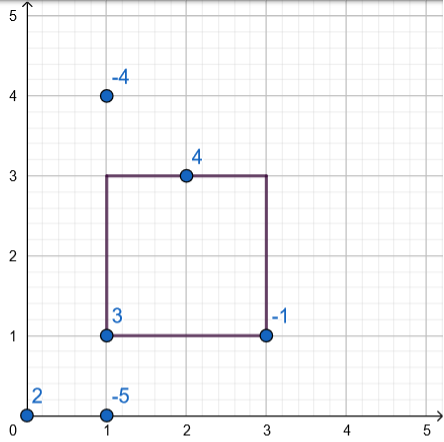A. 2048 Game
乱搞即可。
Code
#include <bits/stdc++.h>
#define MP make_pair
#define fi first
#define se second
#define sz(x) (int)(x).size()
//#define Local
using namespace std;
typedef long long ll;
typedef pair<int, int> pii;
const int N = 1e5 + 5;
int n;
int a[N];
void run() {
cin >> n;
int cnt = 0, cnt1 = 0;
for(int i = 1; i <= n; i++) {
cin >> a[i];
if(a[i] > 2048) continue;
if(a[i] == 1) ++cnt1;
else {
cnt += a[i] / 2;
}
}
cnt += cnt1 / 2;
if(cnt >= 1024) cout << "YES" << '\n';
else cout << "NO" << '\n';
}
int main() {
ios::sync_with_stdio(false);
cin.tie(0); cout.tie(0);
cout << fixed << setprecision(20);
#ifdef Local
freopen("../input.in", "r", stdin);
freopen("../output.out", "w", stdout);
#endif
int q; cin >> q;
while(q--) run();
return 0;
}
B. Knights
直接按奇偶分类其实就行,但我写了个$dfs$...
Code
#include <bits/stdc++.h>
#define MP make_pair
#define fi first
#define se second
#define sz(x) (int)(x).size()
//#define Local
using namespace std;
typedef long long ll;
typedef pair<int, int> pii;
const int N = 105;
int n;
int a[N][N];
int dx[8] = {-2, -2, -1, -1, 2, 2, 1, 1};
int dy[8] = {-1, 1, -2, 2, -1, 1, -2, 2};
bool chk(int x, int y) {
return x <= n && x >= 1 && y >= 1 && y <= n && a[x][y] == 0;
}
void dfs(int x, int y, int c) {
a[x][y] = c;
for(int i = 0; i < 8; i++) {
int nowx = x + dx[i], nowy = y + dy[i];
if(chk(nowx, nowy)) dfs(nowx, nowy, 3 - c);
}
}
void run() {
memset(a, 0, sizeof(a));
dfs(1, 1, 1);
for(int i = 1; i <= n; i++) {
for(int j = 1; j <= n; j++) {
if(a[i][j] == 1) cout << 'W';
else cout << 'B';
}
cout << '\n';
}
}
int main() {
ios::sync_with_stdio(false);
cin.tie(0); cout.tie(0);
cout << fixed << setprecision(20);
#ifdef Local
freopen("../input.in", "r", stdin);
freopen("../output.out", "w", stdout);
#endif
while(cin >> n) run();
return 0;
}
C. Perfect Team
直接输出就行,但我写了个二分...
Code
#include <bits/stdc++.h>
#define MP make_pair
#define fi first
#define se second
#define sz(x) (int)(x).size()
//#define Local
using namespace std;
typedef long long ll;
typedef pair<int, int> pii;
const int N = 1e5 + 5;
int c, m, x;
bool chk(int q) {
int nc = c - q, nm = m - q;
return nc >= 0 && nm >= 0 && nc + nm + x >= q;
}
void run() {
cin >> c >> m >> x;
int ans = min(c, m);
if(x >= ans) {
cout << ans << '\n'; return;
}
int l = 0, r = 100000002, mid;
while(l < r) {
mid = (l + r) >> 1;
if(chk(mid)) l = mid + 1;
else r = mid;
}
cout << r - 1 << '\n';
}
int main() {
ios::sync_with_stdio(false);
cin.tie(0); cout.tie(0);
cout << fixed << setprecision(20);
#ifdef Local
freopen("../input.in", "r", stdin);
freopen("../output.out", "w", stdout);
#endif
int q; cin >> q;
while(q--) run();
return 0;
}
D. Make The Fence Great Again
题意: 给出$n$个数,现在定义一个好的序列为:对于任意相邻的$i,j$,满足$a_i\not ={a_j}$。 现在你可以每次将一个数增加$1$,代价为$b_i$。 问将给出的序列变成好的序列的最小代价为多少。
思路:
- 注意到一个数最多增加两次,因为如果增加的次数大于$2$的话,就会有空隙,填补那个空隙就行了。
- 那么定义$dp[i,j]$表示考虑了前$i$个数,最后一个数增加了$j$次的最小代价,直接枚举转移即可。
代码如下:
Code
#include <bits/stdc++.h>
#define INF 2000000000000000000
#define MP make_pair
#define fi first
#define se second
#define sz(x) (int)(x).size()
//#define Local
using namespace std;
typedef long long ll;
typedef pair<int, int> pii;
const int N = 3e5 + 5;
ll dp[N][5];
int n;
int a[N], b[N];
void run() {
cin >> n;
for(int i = 1; i <= n; i++) cin >> a[i] >> b[i];
for(int i = 0; i <= n; i++) for(int j = 0; j < 5; j++) dp[i][j] = INF;
for(int i = 0; i < 5; i++) dp[0][i] = 0;
for(int i = 1; i <= n; i++) {
for(int j = 0; j < 4; j++) {
for(int k = 0; k < 4; k++) {
if(i == 1 || a[i - 1] + k != a[i] + j) {
dp[i][j] = min(dp[i - 1][k] + 1ll * j * b[i], dp[i][j]);
}
}
}
}
ll ans = INF;
for(int i = 0; i < 4; i++) ans = min(ans, dp[n][i]);
cout << ans << '\n';
}
int main() {
ios::sync_with_stdio(false);
cin.tie(0); cout.tie(0);
cout << fixed << setprecision(20);
#ifdef Local
freopen("../input.in", "r", stdin);
freopen("../output.out", "w", stdout);
#endif
int q; cin >> q;
while(q--) run();
return 0;
}
E. Game With String
题意: 给出一个$01$序列,两个人来玩博弈游戏,博弈规则如下:
- $A$为先手,$B$为后手,给出$a,b,b<a$,$A$能够将$a$个连续的$a$个$0$变为$1$;$B$能够将连续的$b$个$0$变为$1$。
- 当有一个人无法操作时,则输掉这场游戏。
现给出长度不超过$10^5$的序列,问谁胜谁负。
思路: 感觉很有意思的一道博弈题,跟平时遇到的博弈题不一样。感觉不一样就在于游戏规则对于双方来说都不一样,好像是非平衡博弈? 首先有一个很重要的观察:
- 如果存在一段连续的$0$的长度$x$满足:$b\leq x<a$,那么$B$必胜。
简要证明
$B$会比$A$多一次机会。 $A$能搞的$B$也能搞;若出现一个局面,$B$必须用掉这一次机会,那么说明其它位置肯定不存在一段长度大于等于$b$了,自然之后$A$不能再搞了。
那么现在考虑,在什么样的局面下,$B$能够构造出上述观察。 思考可以发现,当存在两段连续$0$的个数都大于等于$2b$时,$B$必然可以构造出这样一段,当然原来就有这么一段就不说了。 发现剩下的情况个数很少,我们直接分类讨论:
- 当不存在任何一个段长度大于等于$2b$时,显然此时所有合法段的长度都是不小于$a$的(前面的情况已经排除)。那么此时的胜负就根据合法段的奇偶个数。
- 当仅存在一个时,既然只有一段,直接枚举$A$在该段上的所有选择,看看存不存在必胜状态就行啦。$A$开始必然在这段区间上面选,不然$B$可以随便构造出满足“观察”的段。
代码如下:
Code
#include <bits/stdc++.h>
#define MP make_pair
#define fi first
#define se second
#define sz(x) (int)(x).size()
#define all(x) (x).begin(), (x).end()
//#define Local
using namespace std;
typedef long long ll;
typedef pair<int, int> pii;
const int N = 3e5 + 5;
char s[N];
int a, b;
void A() {
cout << "YES" << '\n';
}
void B() {
cout << "NO" << '\n';
}
void run() {
vector <int> v;
cin >> a >> b;
cin >> s + 1;
int n = strlen(s + 1);
int cnt = 0;
for(int i = 1; i <= n; i++) {
if(s[i] == '.') ++cnt;
else {
if(cnt) {
v.push_back(cnt);
cnt = 0;
}
}
}
if(cnt) v.push_back(cnt); cnt = 0;
int f = 0;
for(auto it : v) {
if(it >= 2 * b) ++cnt;
if(it >= b && it < a) f = 1;
}
if(f || cnt >= 2) {
B(); return;
}
if(cnt == 0) {
for(auto it : v) {
if(it >= a) ++cnt;
}
if(cnt & 1) A();
else B();
return ;
}
int mx = *max_element(all(v));
cnt = 0;
for(auto it : v) {
if(it != mx && it >= a) ++cnt;
}
for(int l = 1; l + a - 1 <= mx; l++) {
int r = l + a - 1;
int left = l - 1, right = mx - r;
if(left >= 2 * b || right >= 2 * b) continue;
if((left >= b && left < a) || (right >= b && right < a)) continue;
int tmp = cnt + (left >= a) + (right >= a);
if(tmp % 2 == 0) {
A(); return;
}
}
B();
}
int main() {
ios::sync_with_stdio(false);
cin.tie(0); cout.tie(0);
cout << fixed << setprecision(20);
#ifdef Local
freopen("../input.in", "r", stdin);
freopen("../output.out", "w", stdout);
#endif
int q; cin >> q;
while(q--) run();
return 0;
}
F. Choose a Square
题意: 二维平面上给出$n$个点,每个点都有个权值。现在要求选择一个正方形,满足其中一根对角线的两顶点在$y=x$这条直线上。 问所选正方形包含了的点的权值和减去边长的最大值。 类似于这样:  答案为$4$。
答案为$4$。
思路:
因为正方形具有对称性,所以我们可以考虑将$y=x$这条直线下方的点对称过去处理,那么我们现在就相当于选择一个等腰直角三角形的区域,类似于这样:
注意到最终三角形的边上一定存在至少一个点,那么也就是说有用的横纵坐标就为这些点的坐标。
直接枚举$x,y$显然复杂度不能承受,考虑当我们枚举$x$时,选择一个最大的$y$,就类似于维护一个区间最大值。
对于一个位置$x=x_0$,显然随着$y$增大包含的点越多,并且对于一个$y=y_0$而言,与$y=x$这条直线所形成的三角形区域是必选的。类似于这样:
所以线段树的做法就很显然了,横坐标直接从后往前枚举,依次加点并且不断在线段树中插入点的信息并更新区间信息,查询的时候就直接查询最大值以及纵坐标即可。
为什么是更新区间最大值?
因为每插入一个点,它会影响在它右上方的点,当选择右上方的点时,它也必然被包含,类似于这样:(所以直接更新在其上方的区间信息即可)
注意一个细节,因为最后还要减去正方形的边长,对于一个点$(x,y)$而言,正方形边长就为$y-x$,减去就是加上$x-y$。因为我们是按照$y$值建立线段树的,初始答案就为$-y$,最后加上枚举的$x$就行了。
最后还要注意特判一下答案为负的情况,可能答案不包含任何点。 详见代码:
Code
#include <bits/stdc++.h>
#define MP make_pair
#define fi first
#define se second
#define sz(x) (int)(x).size()
#define all(x) (x).begin(), (x).end()
//#define Local
using namespace std;
typedef long long ll;
typedef pair<ll, ll> pll;
const int N = 5e5 + 5;
int n;
vector <int> v;
pll tr[N << 2];
ll add[N << 2];
struct node{
int x, y, c;
bool operator < (const node &A) const{
return x < A.x;
}
}p[N];
void push_up(int o) {
tr[o] = max(tr[o << 1], tr[o << 1|1]);
}
void push_down(int o, int l, int r) {
if(add[o]) {
tr[o << 1].fi += add[o];
tr[o << 1|1].fi += add[o];
add[o << 1] += add[o];
add[o << 1|1] += add[o];
add[o] = 0;
}
}
void build(int o, int l, int r) {
add[o] = 0;
if(l == r) {
tr[o] = MP(-v[l], v[l]);
return;
}
int mid = (l + r) >> 1;
build(o << 1, l, mid); build(o << 1|1, mid + 1, r);
push_up(o);
}
void update(int o, int l, int r, int x, int c) {
if(x <= v[l]) {
tr[o].fi += c;
add[o] += c;
return;
}
push_down(o, l, r);
int mid = (l + r) >> 1;
if(x <= v[mid]) update(o << 1, l, mid, x, c);
update(o << 1|1, mid + 1, r, x, c);
push_up(o);
}
pll query(int o, int l, int r, int L) {
if(L > v[r]) return MP(-1000000009, 0);
if(L <= v[l]) return tr[o];
push_down(o, l, r);
int mid = (l + r) >> 1;
pll ret = max(query(o << 1, l, mid, L), query(o << 1|1, mid + 1, r, L));
return ret;
}
void run() {
v.clear();
for(int i = 1; i <= n; i++) {
int x, y, c; cin >> x >> y >> c;
if(x > y) swap(x, y);
p[i] = {x, y, c};
v.push_back(y);
}
sort(all(v));
v.erase(unique(all(v)), v.end());
build(1, 0, sz(v) - 1);
sort(p + 1, p + n + 1);
p[0].x = -1;
pll ans = MP(-1000000009, 0);
int ansx;
for(int i = n; i >= 1; i--) {
update(1, 0, sz(v) - 1, p[i].y, p[i].c);
if(p[i - 1].x != p[i].x) {
pll ret = query(1, 0, sz(v) - 1, p[i].x);
ret.fi += p[i].x;
if(ret > ans) {
ans = ret;
ansx = p[i].x;
}
}
}
if(ans.fi < 0) {
ans = MP(0, 1000000001), ansx = 1000000001;
}
cout << ans.fi << ' ' << ansx << ' ' << ansx << ' ' << ans.se << ' ' << ans.se << '\n';
}
int main() {
ios::sync_with_stdio(false);
cin.tie(0); cout.tie(0);
cout << fixed << setprecision(20);
#ifdef Local
freopen("../input.in", "r", stdin);
freopen("../output.out", "w", stdout);
#endif
while(cin >> n) run();
return 0;
}













